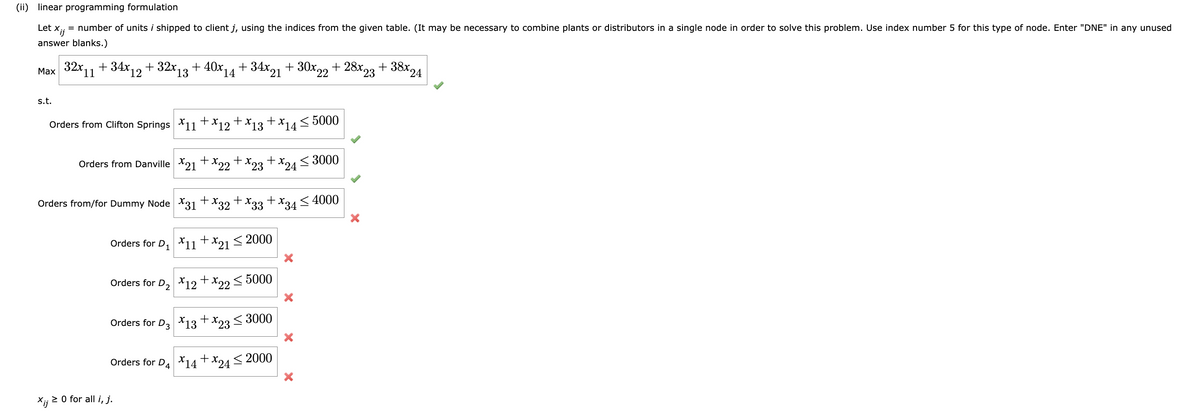(H) linear programming formulation Let x- number of units i shipped to client j, using the indices from the given table. (It may be necessary to combine plants or distributors in a single node in order to solve this problem. Use index number 5 for this type of node. Enter "DNE" in any unused answer blanks.) Max 32r1 +34x,2 + 32r13 + 40x14 + 34x21 + 30x + 28x + 38x24 s.t. Orders from Clifton Springs X11 +x12 +x13+x14 < 5000 Orders from Danville X21 +X22 +x23 + X24S3000 Orders from/for Dummy Node X3I +x32 + x33 +x34S 4000 Orders for D, Xu +x21 S 2000 Orders for D, X12 +X22S 5000 Orders for D, X13 + X23 < 3000 Orders for D. X14 +x24S 2000 Xy 2 0 for all 1, j.
(H) linear programming formulation Let x- number of units i shipped to client j, using the indices from the given table. (It may be necessary to combine plants or distributors in a single node in order to solve this problem. Use index number 5 for this type of node. Enter "DNE" in any unused answer blanks.) Max 32r1 +34x,2 + 32r13 + 40x14 + 34x21 + 30x + 28x + 38x24 s.t. Orders from Clifton Springs X11 +x12 +x13+x14 < 5000 Orders from Danville X21 +X22 +x23 + X24S3000 Orders from/for Dummy Node X3I +x32 + x33 +x34S 4000 Orders for D, Xu +x21 S 2000 Orders for D, X12 +X22S 5000 Orders for D, X13 + X23 < 3000 Orders for D. X14 +x24S 2000 Xy 2 0 for all 1, j.
Practical Management Science
6th Edition
ISBN:9781337406659
Author:WINSTON, Wayne L.
Publisher:WINSTON, Wayne L.
Chapter2: Introduction To Spreadsheet Modeling
Section: Chapter Questions
Problem 20P: Julie James is opening a lemonade stand. She believes the fixed cost per week of running the stand...
Related questions
Question
Please help with constraints. Question provided below with data. Not sure why the dummy constraint is incorrect.

Transcribed Image Text:(ii) linear programming formulation
Let Xj
= number of units i shipped to client j, using the indices from the given table. (It may be necessary to combine plants or distributors in a single node in order to solve this problem. Use index number 5 for this type of node. Enter "DNE" in any unused
answer blanks.)
32x11+34x12
+ 32x13
+ 40x14
+ 34x21 + 30x22 + 28x23
+ 38x24
Маx
s.t.
+x,
+
Orders from Clifton Springs X11 †*12 + *13 x14< 5000
+
+
+
3000
Orders from Danville X21 X22 † *23 † 24
Orders from/for Dummy Node X31 † X32 † X33 + X34 < 4000
Orders for D, X11+x21 < 2000
Orders for D, X12+x22< 5000
Orders for D3 X13 +x23 < 3000
Orders for D4 *14
+ x24 < 2000
Xj 2 0 for all i, j.

Transcribed Image Text:Klein Chemicals, Inc., produces a special oil-based material that is currently in short supply. Four of Klein's customers have already placed orders that together exceed the combined capacity of Klein's two plants. Klein's management faces the problem of deciding how many
units it should supply to each customer. Because the four customers are in different industries, different prices can be charged because of the various industry pricing structures. However, slightly different production costs at the two plants and varying transportation costs
between the plants and customers make a "sell to the highest bidder" strategy unacceptable. After considering price, production costs, and transportation costs, Klein established the following profit per unit for each plant-customer alternative.
Customer
Plant
3
1
D2
1
D3
D4
Clifton Springs
$32
$34
$32
$40
Danville
$34
$30
$28
$38
The plant capacities and customer orders are as follows.
Plant
Capacity (units)
Distributor Orders (units)
Clifton Springs
5,000
D1
2,000
Danville
3,000
D2
5,000
D3
3,000
D4
2,000
Expert Solution
Step 1 - Introduction
Given data is

As the capacity was less than demand a dummy row is added.
Trending now
This is a popular solution!
Step by step
Solved in 4 steps with 8 images

Recommended textbooks for you

Practical Management Science
Operations Management
ISBN:
9781337406659
Author:
WINSTON, Wayne L.
Publisher:
Cengage,

Operations Management
Operations Management
ISBN:
9781259667473
Author:
William J Stevenson
Publisher:
McGraw-Hill Education

Operations and Supply Chain Management (Mcgraw-hi…
Operations Management
ISBN:
9781259666100
Author:
F. Robert Jacobs, Richard B Chase
Publisher:
McGraw-Hill Education

Practical Management Science
Operations Management
ISBN:
9781337406659
Author:
WINSTON, Wayne L.
Publisher:
Cengage,

Operations Management
Operations Management
ISBN:
9781259667473
Author:
William J Stevenson
Publisher:
McGraw-Hill Education

Operations and Supply Chain Management (Mcgraw-hi…
Operations Management
ISBN:
9781259666100
Author:
F. Robert Jacobs, Richard B Chase
Publisher:
McGraw-Hill Education


Purchasing and Supply Chain Management
Operations Management
ISBN:
9781285869681
Author:
Robert M. Monczka, Robert B. Handfield, Larry C. Giunipero, James L. Patterson
Publisher:
Cengage Learning

Production and Operations Analysis, Seventh Editi…
Operations Management
ISBN:
9781478623069
Author:
Steven Nahmias, Tava Lennon Olsen
Publisher:
Waveland Press, Inc.